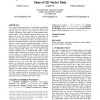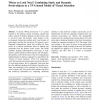27 search results - page 3 / 6 » A Geographer Looks at Spatial Information Theory |
168
click to vote
GIS
2007
ACM
16 years 22 days ago
2007
ACM
The collection of moving object data is becoming more and more common, and therefore there is an increasing need for the efficient analysis and knowledge extraction of these data ...
101
click to vote
KR
1998
Springer
15 years 3 months ago
1998
Springer
This paper presents a method for reasoning about spatial objects and their qualitative spatial relationships. In contrast to existing work, which mainly focusses on reasoning abou...
112
click to vote
FSKD
2010
Springer
14 years 9 months ago
2010
Springer
Uncertainty is the intrinsic property of spatial data and one of important factors affecting the course of spatial data mining. There are diversiform forms for the essentiality an...
224
click to vote
GIS
2006
ACM
16 years 21 days ago
2006
ACM
If you were told that some object A was perfectly (or somewhat, or not at all) in some direction (e.g., west, above-right) of some reference object B, where in space would you loo...
107
click to vote
COGCOM
2010
14 years 9 months ago
2010
To decide ``Where to look next ?'' is a central function of the attention system of humans, animals and robots. Control of attention depends on three factors, that is, lo...


